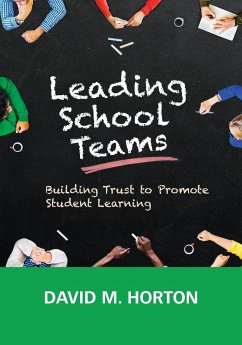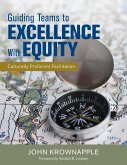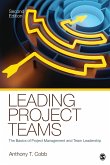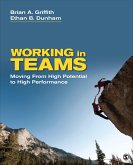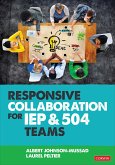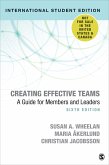- Broschiertes Buch
- Merkliste
- Auf die Merkliste
- Bewerten Bewerten
- Teilen
- Produkt teilen
- Produkterinnerung
- Produkterinnerung
With ready-to-use tools, this guide will help school leaders connect people, build trust, discover strengths, and clear barriers to improve teacher effectiveness - and ultimately raise student achievement.
Andere Kunden interessierten sich auch für
![Leading People and Teams in Education Leading People and Teams in Education]() Lesley Kydd / Lesley Anderson / Wendy Newton (eds.)Leading People and Teams in Education67,99 €
Lesley Kydd / Lesley Anderson / Wendy Newton (eds.)Leading People and Teams in Education67,99 €![Guiding Teams to Excellence With Equity Guiding Teams to Excellence With Equity]() John J. KrownappleGuiding Teams to Excellence With Equity35,99 €
John J. KrownappleGuiding Teams to Excellence With Equity35,99 €![Leading Project Teams Leading Project Teams]() Anthony T. CobbLeading Project Teams103,99 €
Anthony T. CobbLeading Project Teams103,99 €![Working in Teams Working in Teams]() Brian A. GriffithWorking in Teams136,99 €
Brian A. GriffithWorking in Teams136,99 €![Responsive Collaboration for IEP and 504 Teams Responsive Collaboration for IEP and 504 Teams]() Albert Johnson-Mussad (Educational consultant and coach)Responsive Collaboration for IEP and 504 Teams44,99 €
Albert Johnson-Mussad (Educational consultant and coach)Responsive Collaboration for IEP and 504 Teams44,99 €![Creating Effective Teams - International Student Edition Creating Effective Teams - International Student Edition]() Susan A. WheelanCreating Effective Teams - International Student Edition77,99 €
Susan A. WheelanCreating Effective Teams - International Student Edition77,99 €![Leading for Change Through Whole-School Social-Emotional Learning Leading for Change Through Whole-School Social-Emotional Learning]() Jennifer E RogersLeading for Change Through Whole-School Social-Emotional Learning40,99 €
Jennifer E RogersLeading for Change Through Whole-School Social-Emotional Learning40,99 €-
-
-
With ready-to-use tools, this guide will help school leaders connect people, build trust, discover strengths, and clear barriers to improve teacher effectiveness - and ultimately raise student achievement.
Hinweis: Dieser Artikel kann nur an eine deutsche Lieferadresse ausgeliefert werden.
Hinweis: Dieser Artikel kann nur an eine deutsche Lieferadresse ausgeliefert werden.
Produktdetails
- Produktdetails
- Verlag: SAGE Publications Inc
- Seitenzahl: 202
- Erscheinungstermin: 19. Oktober 2016
- Englisch
- Abmessung: 254mm x 178mm x 11mm
- Gewicht: 428g
- ISBN-13: 9781506344928
- ISBN-10: 1506344925
- Artikelnr.: 44973282
- Herstellerkennzeichnung
- Books on Demand GmbH
- In de Tarpen 42
- 22848 Norderstedt
- info@bod.de
- 040 53433511
- Verlag: SAGE Publications Inc
- Seitenzahl: 202
- Erscheinungstermin: 19. Oktober 2016
- Englisch
- Abmessung: 254mm x 178mm x 11mm
- Gewicht: 428g
- ISBN-13: 9781506344928
- ISBN-10: 1506344925
- Artikelnr.: 44973282
- Herstellerkennzeichnung
- Books on Demand GmbH
- In de Tarpen 42
- 22848 Norderstedt
- info@bod.de
- 040 53433511
David Horton is a lifelong educator. He has served as an Assistant Superintendent of Educational Services, a K-12 Director of Curriculum, Instruction, and Assessment; Coordinator of Secondary Mathematics and K-12 Instructional Technology; high school Assistant Principal; and high school math and science teacher. David's area of expertise is building systems and structures of organizational leadership that align mission and vision with practice. He currently teaches as an adjunct professor with two Southern California universities. David has a Bachelor of Science in Biology and Master of Education from the University of California, Los Angeles (UCLA). He received a Master of Science degree in Administration from Pepperdine University and earned a Doctor of Education degree in Organizational Leadership from the University of La Verne. David resides in Southern California with his wife and two children.
Acknowledgments
About the Author
Introduction
Sustained Improvement Requires Teams
What This Book Is-What This Book Isn't
Quick-Start Diagnostic
Making a Selection
Putting It All Together
Activity Guidelines
Components of Team Activities
PART I. EXAMINATION AND IDENTIFICATION OF THE PROBLEM
Chapter 1. Learning Leadership
Leaders and Teams
The Realities in the Leadership of Learning
Application Activity 1.1-Assessing Your Organizational, Team, and Personal
Strengths
Application Activity 1.2-Effective Learning Leaders
Application Activity 1.3-Strong Learning Teams Exhibit Common
Characteristics
Conclusion
Chapter 2. A Problem Worth Solving and the Ideas to Solve It (the Filters)
Introduction
Ideas Are Fragile-Ideas Are Delicate
The Fosbury Flop, Ski Jumping, and Newton
Application Activity 2.1-Treating Ideas in a Learning Organization
Application Activity 2.2-Ideas That Don't Work: Part of the Process
Application Activity 2.3-It Takes Other People Sooner or Later
Application Activity 2.4-Who and What You Have Around You
Deeper Use of This Chapter (Deeper Dive)
Conclusion
Chapter 3. Why Solve the Problem That Needs Solving (the Filters)
Introduction
Application Activity 3.1-What the Result of a Great Decision Looks Like
Application Activity 3.2- Reasons to Have the Idea in the First Place
Application Activity 3.3-The Problem That Needs Solving: Clear, Concise
Application Activity 3.4-The Role of the Leader in Developing Ideas
Application Activity 3.5-Harnessing the Forces Around You
Deeper Use of This Chapter: Deeper Dives
Conclusion
PART II-INTROSPECTION, BEHAVIORS, TYPES: THE HOW AND WHO TO SOLVE PROBLEMS
Chapter 4. How the Problem Is Solved
Introduction
Application Activity 4.1- Importance of a Process
Application Activity 4.2-Trust
Application Activity 4.3-Fear of Conflict
Application Activity 4.4-Commitment
Application Activity 4.5-Accountability
Application Activity 4.6-Attention to Results
Application Activity 4.7-Generating Ideas and Action Steps
Deeper Use of This Chapter: Reusable Prompts
Deeper Use of This Chapter: Deeper Dives
Conclusion
Chapter 5. The People Who Will Solve the Problem
Introduction
Application Activity 5.1-Know How to Build and Use People
Application Activity 5.2-The Chemistry of the Team
Application Activity 5.3-Managing the Creative Team
Application Activity 5.4-Handling Conflict in the Ideas From the Team
Deeper Use of This Chapter: Deeper Dives
Conclusion
Chapter 6. The People in the Room (the Types)
Introduction
The Assessment
The Basics
Application Activity 6.1-Part 1/Type 1: The Idea
Application Activity 6.2-Part 2/Type 2: Organization and Execution
Application Activity 6.3-Part 3/Type 3: Forces of Community
Application Activity 6.4-Part 4/Type 4: Leadership Capacity
Using the Four Types
Conclusion
PART III. FUNCTIONALITY OF THE TEAM
Chapter 7. People, Leadership, Support (the Fuel Sources)
Introduction
Fuel Source A: The People
Application Activity 7.1-Who
Application Activity 7.2-What
Application Activity 7.3-How (Coaching)
Deeper Use of This Chapter: Deeper Dives
Fuel Source B: The Resource of Leadership
Application Activity 7.4-Keep Things Moving (Management Leadership)
Application Activity 7.5-Keep People Moving (Leadership Management)
Deeper Use of This Chapter: Deeper Dives
Fuel Source C: The Supports
Application Activity 7.6-Gather, Collect, Assess
Application Activity 7.7-Feedback
Application Activity 7.8-Systems and Barriers
Application Activity 7.9-Performance
Deeper Use of This Chapter: Deeper Dives
Conclusion
Chapter 8. Team Dynamics, Blunders, Traps, Directions, and Connecting Dots
(the Pink Elephants)
Introduction
Application Activity 8.1-Pink Elephants
Application Activity 8.2-Team Dynamics
Application Activity 8.3-The Blunders
Application Activity 8.4-The Traps
Application Activity 8.5-Ideas as Direction
Application Activity 8.6-Connect the Dots
Deeper Use of This Chapter: Deeper Dives
Conclusion
Chapter 9. Performance, Feedback, and Other Ways to Support, Maim, or Kill
a Team (the Good, the Dangerous, and the Lethal)
Introduction
Application Activity 9.1-The Good: Selling the Idea: A Picture Is Worth
1,000 Words
Application Activity 9.2-The Good: Communication and Frequency
Application Activity 9.3-The Good: Ingredients of the High-Performing Team
Application Activity 9.4-The Dangerous: Planning Mistakes
Application Activity 9.5-The Lethal: Lack of Feedback, Feedback, Feedback
Application Activity 9.6-The Lethal: Mistaken Assumptions of People and
Meetings
Conclusion
Chapter 10. Leadership, Support, Structure, and Conclusion
Leadership
Support
Structure-The Overall Structure: The First 15 Minutes, the Next 45 Minutes
Conclusion
References
Index
About the Author
Introduction
Sustained Improvement Requires Teams
What This Book Is-What This Book Isn't
Quick-Start Diagnostic
Making a Selection
Putting It All Together
Activity Guidelines
Components of Team Activities
PART I. EXAMINATION AND IDENTIFICATION OF THE PROBLEM
Chapter 1. Learning Leadership
Leaders and Teams
The Realities in the Leadership of Learning
Application Activity 1.1-Assessing Your Organizational, Team, and Personal
Strengths
Application Activity 1.2-Effective Learning Leaders
Application Activity 1.3-Strong Learning Teams Exhibit Common
Characteristics
Conclusion
Chapter 2. A Problem Worth Solving and the Ideas to Solve It (the Filters)
Introduction
Ideas Are Fragile-Ideas Are Delicate
The Fosbury Flop, Ski Jumping, and Newton
Application Activity 2.1-Treating Ideas in a Learning Organization
Application Activity 2.2-Ideas That Don't Work: Part of the Process
Application Activity 2.3-It Takes Other People Sooner or Later
Application Activity 2.4-Who and What You Have Around You
Deeper Use of This Chapter (Deeper Dive)
Conclusion
Chapter 3. Why Solve the Problem That Needs Solving (the Filters)
Introduction
Application Activity 3.1-What the Result of a Great Decision Looks Like
Application Activity 3.2- Reasons to Have the Idea in the First Place
Application Activity 3.3-The Problem That Needs Solving: Clear, Concise
Application Activity 3.4-The Role of the Leader in Developing Ideas
Application Activity 3.5-Harnessing the Forces Around You
Deeper Use of This Chapter: Deeper Dives
Conclusion
PART II-INTROSPECTION, BEHAVIORS, TYPES: THE HOW AND WHO TO SOLVE PROBLEMS
Chapter 4. How the Problem Is Solved
Introduction
Application Activity 4.1- Importance of a Process
Application Activity 4.2-Trust
Application Activity 4.3-Fear of Conflict
Application Activity 4.4-Commitment
Application Activity 4.5-Accountability
Application Activity 4.6-Attention to Results
Application Activity 4.7-Generating Ideas and Action Steps
Deeper Use of This Chapter: Reusable Prompts
Deeper Use of This Chapter: Deeper Dives
Conclusion
Chapter 5. The People Who Will Solve the Problem
Introduction
Application Activity 5.1-Know How to Build and Use People
Application Activity 5.2-The Chemistry of the Team
Application Activity 5.3-Managing the Creative Team
Application Activity 5.4-Handling Conflict in the Ideas From the Team
Deeper Use of This Chapter: Deeper Dives
Conclusion
Chapter 6. The People in the Room (the Types)
Introduction
The Assessment
The Basics
Application Activity 6.1-Part 1/Type 1: The Idea
Application Activity 6.2-Part 2/Type 2: Organization and Execution
Application Activity 6.3-Part 3/Type 3: Forces of Community
Application Activity 6.4-Part 4/Type 4: Leadership Capacity
Using the Four Types
Conclusion
PART III. FUNCTIONALITY OF THE TEAM
Chapter 7. People, Leadership, Support (the Fuel Sources)
Introduction
Fuel Source A: The People
Application Activity 7.1-Who
Application Activity 7.2-What
Application Activity 7.3-How (Coaching)
Deeper Use of This Chapter: Deeper Dives
Fuel Source B: The Resource of Leadership
Application Activity 7.4-Keep Things Moving (Management Leadership)
Application Activity 7.5-Keep People Moving (Leadership Management)
Deeper Use of This Chapter: Deeper Dives
Fuel Source C: The Supports
Application Activity 7.6-Gather, Collect, Assess
Application Activity 7.7-Feedback
Application Activity 7.8-Systems and Barriers
Application Activity 7.9-Performance
Deeper Use of This Chapter: Deeper Dives
Conclusion
Chapter 8. Team Dynamics, Blunders, Traps, Directions, and Connecting Dots
(the Pink Elephants)
Introduction
Application Activity 8.1-Pink Elephants
Application Activity 8.2-Team Dynamics
Application Activity 8.3-The Blunders
Application Activity 8.4-The Traps
Application Activity 8.5-Ideas as Direction
Application Activity 8.6-Connect the Dots
Deeper Use of This Chapter: Deeper Dives
Conclusion
Chapter 9. Performance, Feedback, and Other Ways to Support, Maim, or Kill
a Team (the Good, the Dangerous, and the Lethal)
Introduction
Application Activity 9.1-The Good: Selling the Idea: A Picture Is Worth
1,000 Words
Application Activity 9.2-The Good: Communication and Frequency
Application Activity 9.3-The Good: Ingredients of the High-Performing Team
Application Activity 9.4-The Dangerous: Planning Mistakes
Application Activity 9.5-The Lethal: Lack of Feedback, Feedback, Feedback
Application Activity 9.6-The Lethal: Mistaken Assumptions of People and
Meetings
Conclusion
Chapter 10. Leadership, Support, Structure, and Conclusion
Leadership
Support
Structure-The Overall Structure: The First 15 Minutes, the Next 45 Minutes
Conclusion
References
Index
Acknowledgments
About the Author
Introduction
Sustained Improvement Requires Teams
What This Book Is-What This Book Isn't
Quick-Start Diagnostic
Making a Selection
Putting It All Together
Activity Guidelines
Components of Team Activities
PART I. EXAMINATION AND IDENTIFICATION OF THE PROBLEM
Chapter 1. Learning Leadership
Leaders and Teams
The Realities in the Leadership of Learning
Application Activity 1.1-Assessing Your Organizational, Team, and Personal
Strengths
Application Activity 1.2-Effective Learning Leaders
Application Activity 1.3-Strong Learning Teams Exhibit Common
Characteristics
Conclusion
Chapter 2. A Problem Worth Solving and the Ideas to Solve It (the Filters)
Introduction
Ideas Are Fragile-Ideas Are Delicate
The Fosbury Flop, Ski Jumping, and Newton
Application Activity 2.1-Treating Ideas in a Learning Organization
Application Activity 2.2-Ideas That Don't Work: Part of the Process
Application Activity 2.3-It Takes Other People Sooner or Later
Application Activity 2.4-Who and What You Have Around You
Deeper Use of This Chapter (Deeper Dive)
Conclusion
Chapter 3. Why Solve the Problem That Needs Solving (the Filters)
Introduction
Application Activity 3.1-What the Result of a Great Decision Looks Like
Application Activity 3.2- Reasons to Have the Idea in the First Place
Application Activity 3.3-The Problem That Needs Solving: Clear, Concise
Application Activity 3.4-The Role of the Leader in Developing Ideas
Application Activity 3.5-Harnessing the Forces Around You
Deeper Use of This Chapter: Deeper Dives
Conclusion
PART II-INTROSPECTION, BEHAVIORS, TYPES: THE HOW AND WHO TO SOLVE PROBLEMS
Chapter 4. How the Problem Is Solved
Introduction
Application Activity 4.1- Importance of a Process
Application Activity 4.2-Trust
Application Activity 4.3-Fear of Conflict
Application Activity 4.4-Commitment
Application Activity 4.5-Accountability
Application Activity 4.6-Attention to Results
Application Activity 4.7-Generating Ideas and Action Steps
Deeper Use of This Chapter: Reusable Prompts
Deeper Use of This Chapter: Deeper Dives
Conclusion
Chapter 5. The People Who Will Solve the Problem
Introduction
Application Activity 5.1-Know How to Build and Use People
Application Activity 5.2-The Chemistry of the Team
Application Activity 5.3-Managing the Creative Team
Application Activity 5.4-Handling Conflict in the Ideas From the Team
Deeper Use of This Chapter: Deeper Dives
Conclusion
Chapter 6. The People in the Room (the Types)
Introduction
The Assessment
The Basics
Application Activity 6.1-Part 1/Type 1: The Idea
Application Activity 6.2-Part 2/Type 2: Organization and Execution
Application Activity 6.3-Part 3/Type 3: Forces of Community
Application Activity 6.4-Part 4/Type 4: Leadership Capacity
Using the Four Types
Conclusion
PART III. FUNCTIONALITY OF THE TEAM
Chapter 7. People, Leadership, Support (the Fuel Sources)
Introduction
Fuel Source A: The People
Application Activity 7.1-Who
Application Activity 7.2-What
Application Activity 7.3-How (Coaching)
Deeper Use of This Chapter: Deeper Dives
Fuel Source B: The Resource of Leadership
Application Activity 7.4-Keep Things Moving (Management Leadership)
Application Activity 7.5-Keep People Moving (Leadership Management)
Deeper Use of This Chapter: Deeper Dives
Fuel Source C: The Supports
Application Activity 7.6-Gather, Collect, Assess
Application Activity 7.7-Feedback
Application Activity 7.8-Systems and Barriers
Application Activity 7.9-Performance
Deeper Use of This Chapter: Deeper Dives
Conclusion
Chapter 8. Team Dynamics, Blunders, Traps, Directions, and Connecting Dots
(the Pink Elephants)
Introduction
Application Activity 8.1-Pink Elephants
Application Activity 8.2-Team Dynamics
Application Activity 8.3-The Blunders
Application Activity 8.4-The Traps
Application Activity 8.5-Ideas as Direction
Application Activity 8.6-Connect the Dots
Deeper Use of This Chapter: Deeper Dives
Conclusion
Chapter 9. Performance, Feedback, and Other Ways to Support, Maim, or Kill
a Team (the Good, the Dangerous, and the Lethal)
Introduction
Application Activity 9.1-The Good: Selling the Idea: A Picture Is Worth
1,000 Words
Application Activity 9.2-The Good: Communication and Frequency
Application Activity 9.3-The Good: Ingredients of the High-Performing Team
Application Activity 9.4-The Dangerous: Planning Mistakes
Application Activity 9.5-The Lethal: Lack of Feedback, Feedback, Feedback
Application Activity 9.6-The Lethal: Mistaken Assumptions of People and
Meetings
Conclusion
Chapter 10. Leadership, Support, Structure, and Conclusion
Leadership
Support
Structure-The Overall Structure: The First 15 Minutes, the Next 45 Minutes
Conclusion
References
Index
About the Author
Introduction
Sustained Improvement Requires Teams
What This Book Is-What This Book Isn't
Quick-Start Diagnostic
Making a Selection
Putting It All Together
Activity Guidelines
Components of Team Activities
PART I. EXAMINATION AND IDENTIFICATION OF THE PROBLEM
Chapter 1. Learning Leadership
Leaders and Teams
The Realities in the Leadership of Learning
Application Activity 1.1-Assessing Your Organizational, Team, and Personal
Strengths
Application Activity 1.2-Effective Learning Leaders
Application Activity 1.3-Strong Learning Teams Exhibit Common
Characteristics
Conclusion
Chapter 2. A Problem Worth Solving and the Ideas to Solve It (the Filters)
Introduction
Ideas Are Fragile-Ideas Are Delicate
The Fosbury Flop, Ski Jumping, and Newton
Application Activity 2.1-Treating Ideas in a Learning Organization
Application Activity 2.2-Ideas That Don't Work: Part of the Process
Application Activity 2.3-It Takes Other People Sooner or Later
Application Activity 2.4-Who and What You Have Around You
Deeper Use of This Chapter (Deeper Dive)
Conclusion
Chapter 3. Why Solve the Problem That Needs Solving (the Filters)
Introduction
Application Activity 3.1-What the Result of a Great Decision Looks Like
Application Activity 3.2- Reasons to Have the Idea in the First Place
Application Activity 3.3-The Problem That Needs Solving: Clear, Concise
Application Activity 3.4-The Role of the Leader in Developing Ideas
Application Activity 3.5-Harnessing the Forces Around You
Deeper Use of This Chapter: Deeper Dives
Conclusion
PART II-INTROSPECTION, BEHAVIORS, TYPES: THE HOW AND WHO TO SOLVE PROBLEMS
Chapter 4. How the Problem Is Solved
Introduction
Application Activity 4.1- Importance of a Process
Application Activity 4.2-Trust
Application Activity 4.3-Fear of Conflict
Application Activity 4.4-Commitment
Application Activity 4.5-Accountability
Application Activity 4.6-Attention to Results
Application Activity 4.7-Generating Ideas and Action Steps
Deeper Use of This Chapter: Reusable Prompts
Deeper Use of This Chapter: Deeper Dives
Conclusion
Chapter 5. The People Who Will Solve the Problem
Introduction
Application Activity 5.1-Know How to Build and Use People
Application Activity 5.2-The Chemistry of the Team
Application Activity 5.3-Managing the Creative Team
Application Activity 5.4-Handling Conflict in the Ideas From the Team
Deeper Use of This Chapter: Deeper Dives
Conclusion
Chapter 6. The People in the Room (the Types)
Introduction
The Assessment
The Basics
Application Activity 6.1-Part 1/Type 1: The Idea
Application Activity 6.2-Part 2/Type 2: Organization and Execution
Application Activity 6.3-Part 3/Type 3: Forces of Community
Application Activity 6.4-Part 4/Type 4: Leadership Capacity
Using the Four Types
Conclusion
PART III. FUNCTIONALITY OF THE TEAM
Chapter 7. People, Leadership, Support (the Fuel Sources)
Introduction
Fuel Source A: The People
Application Activity 7.1-Who
Application Activity 7.2-What
Application Activity 7.3-How (Coaching)
Deeper Use of This Chapter: Deeper Dives
Fuel Source B: The Resource of Leadership
Application Activity 7.4-Keep Things Moving (Management Leadership)
Application Activity 7.5-Keep People Moving (Leadership Management)
Deeper Use of This Chapter: Deeper Dives
Fuel Source C: The Supports
Application Activity 7.6-Gather, Collect, Assess
Application Activity 7.7-Feedback
Application Activity 7.8-Systems and Barriers
Application Activity 7.9-Performance
Deeper Use of This Chapter: Deeper Dives
Conclusion
Chapter 8. Team Dynamics, Blunders, Traps, Directions, and Connecting Dots
(the Pink Elephants)
Introduction
Application Activity 8.1-Pink Elephants
Application Activity 8.2-Team Dynamics
Application Activity 8.3-The Blunders
Application Activity 8.4-The Traps
Application Activity 8.5-Ideas as Direction
Application Activity 8.6-Connect the Dots
Deeper Use of This Chapter: Deeper Dives
Conclusion
Chapter 9. Performance, Feedback, and Other Ways to Support, Maim, or Kill
a Team (the Good, the Dangerous, and the Lethal)
Introduction
Application Activity 9.1-The Good: Selling the Idea: A Picture Is Worth
1,000 Words
Application Activity 9.2-The Good: Communication and Frequency
Application Activity 9.3-The Good: Ingredients of the High-Performing Team
Application Activity 9.4-The Dangerous: Planning Mistakes
Application Activity 9.5-The Lethal: Lack of Feedback, Feedback, Feedback
Application Activity 9.6-The Lethal: Mistaken Assumptions of People and
Meetings
Conclusion
Chapter 10. Leadership, Support, Structure, and Conclusion
Leadership
Support
Structure-The Overall Structure: The First 15 Minutes, the Next 45 Minutes
Conclusion
References
Index

